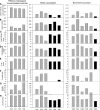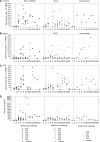Establishment of an aerosol challenge model of tuberculosis in rhesus macaques and an evaluation of endpoints for vaccine testing
- PMID: 20534795
- PMCID: PMC2916246
- DOI: 10.1128/CVI.00079-10
Establishment of an aerosol challenge model of tuberculosis in rhesus macaques and an evaluation of endpoints for vaccine testing
Abstract
The establishment of an aerosol challenge model in nonhuman primates (NHPs) for the testing of vaccines against Mycobacterium tuberculosis would assist the global effort to optimize novel vaccination strategies. The endpoints used in preclinical challenge studies to identify measures of disease burden need to be accurate and sensitive enough to distinguish subtle differences and benefits afforded by different tuberculosis (TB) vaccine regimens when group sizes are inevitably small. This study sought to assess clinical and nonclinical endpoints as potentially sensitive measures of disease burden in a challenge study with rhesus macaques by using a new protocol of aerosol administration of M. tuberculosis. Immunological and clinical readouts were assessed for utility in vaccine evaluation studies. This is the first example of TB vaccine evaluation with rhesus macaques where long-term survival was one of the primary endpoints. However, we found that in NHP vaccine efficacy studies with maximum group sizes of six animals, survival did not provide a valuable endpoint. Two approaches used in human clinical trials for the evaluation of the gamma interferon (IFN-gamma) response to vaccination (enzyme-linked immunospot [ELISpot] assay and enzyme-linked immunosorbent assay [ELISA]) were included in this study. The IFN-gamma profiles induced following vaccination were found not to correlate with protection, nor did the level of purified protein derivative (PPD)-specific proliferation. The only readout to reliably distinguish vaccinated and unvaccinated NHPs was the determination of lung lesion burden using magnetic resonance (MR) imaging combined with stereology at the end of the study. Therefore, the currently proposed key markers were not shown to correlate with protection, and only imaging offered a potentially reliable correlate.
Figures






References
-
- Anacker, R. L., W. Brehmer, W. R. Barclay, W. R. Leif, E. Ribi, J. H. Simmons, and A. W. Smith. 1972. Superiority of intravenously administered BCG and BCG cell walls in protecting rhesus monkeys (Macaca mulatta) against airborne tuberculosis. Z. Immunitatsforsch. Exp. Klin. Immunol. 143:363-376. - PubMed
-
- Barclay, W. R., W. M. Busey, D. W. Dalgard, R. C. Good, B. W. Janicki, J. E. Kasik, E. Ribi, C. E. Ulrich, and E. Wolinsky. 1973. Protection of monkeys against airborne tuberculosis by aerosol vaccination with bacillus Calmette-Guerin. Am. Rev. Respir. Dis. 107:351-358. - PubMed
-
- Basaraba, R. J. 2008. Experimental tuberculosis: the role of comparative pathology in the discovery of improved tuberculosis treatment strategies. Tuberculosis (Edinb.) 88(Suppl. 1):S35-S47. - PubMed
-
- Black, G. F., P. E. M. Fine, D. K. Warndorff, S. Floyd, R. E. Weir, J. M. Blackwell, L. Bliss, L. Sichali, L. Mwaungulu, S. Chaguluka, E. Jarman, B. Ngwira, and H. M. Dockrell. 2001. Relationship between IFN-gamma and skin test responsiveness to Mycobacterium tuberculosis PPD in healthy, non-BCG-vaccinated young adults in Northern Malawi. Int. J. Tuber. Lung Dis. 5:664-672. - PubMed
Publication types
MeSH terms
Substances
Grants and funding
LinkOut - more resources
Full Text Sources
Other Literature Sources

